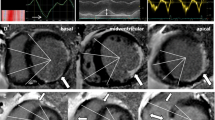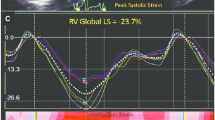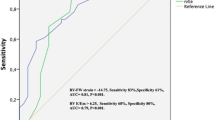Abstract
Diagnosis of right ventricular (RV) infarction in the setting of acute inferior wall myocardial infarction (IWMI) has important prognostic implications. We sought to assess the role of 2-D speckle tracking echocardiography (2-D STE) for the assessment of RV involvement in acute IWMI. We included 100 consecutive patients with a diagnosis of recent IWMI, of which 73 had an RCA culprit lesion, undergoing primary percutaneous coronary intervention (PPCI). Patients (n = 73) were classified into 2 groups based on angiographic evidence of RV involvement (lesions proximal to or involving RV branch versus distal lesions). Echocardiographic features of RV dysfunction were assessed using conventional 2-D echocardiographic, and Tissue Doppler parameters as well as 2-D speckle tracking echocardiography. Out of the 73 patients, 42 had RCA lesion proximal to or involving RV branch, while 31 patients had RCA culprit distal to RV branch. Among different parameters assessing RV function, only RV-FWLS was significantly lower among the former group (− 14.2 ± 4.6 vs. − 17.7 ± 4.2, p = 0.026). Receiver-operator characteristic (ROC) analysis showed that RV-FWLS had the strongest discriminatory capability to identify RV infarction (AUC = 0.7, p = 0.02, 95% CI 0.53–0.78). A cut-off value of RV-FWLS ≤ − 20.5% had 88% sensitivity and 33% specificity for diagnosis of RV infarction. STE-derived RV-FWLS with cutoff ≤ − 20.5% could be a reliable and promising tool for prediction of RV involvement in the setting of acute IWMI, which could guide proper risk stratification and tailored acute management strategy.



Similar content being viewed by others
References
Andersen HR, Nielsen D, Falk E (1989) Right ventricular infarction: larger enzyme release with posterior than with anterior involvement. Int J Cardiol 22:347–355. https://doi.org/10.1016/0167-5273(89)90276-3
Klein H, Tordjman T, Ninio R et al (1983) The early recognition of right ventricular infarction: diagnostic accuracy of the electrocardiographic V4R Lead. Circulation 67:558–565
Wagner GS, Macfarlane P, Wellens H et al (2009) AHA/ACCF/HRS recommendations for the standardization and interpretation of the electrocardiogram. Part VI: Acute Ischemia/Infarction A Scientific Statement From the American Heart Association Electrocardiography and Arrhythmias Committee, Council on Clini. J Am Coll Cardiol 53:1003–1011. https://doi.org/10.1016/j.jacc.2008.12.016
Andersn HR, Falk E, Nielsen D (1987) Right ventricular infarction: frequency, size and topography in coronary heart disease: a prospective study comprising 107 consecutive autopsies from a coronary care unit. J Am Coll Cardiol 10:1223–1232. https://doi.org/10.1016/S0735-1097(87)80122-5
Javed S, Rajani AR, Govindaswamy P et al (2017) Right ventricular involvement in patients with inferior myocardial infarction, correlation of electrocardiographic findings with echocardiography data. J Pak Med Assoc 67:442–445
Zornoff LAM, Skali H, Pfeffer MA et al (2002) Right ventricular dysfunction and risk of heart failure and mortality after myocardial infarction. J Am Coll Cardiol 39:1450–1455. https://doi.org/10.1016/S0735-1097(02)01804-1
O’Rourke R, Dell’Italia L (2004) Diagnosis and management of right ventricular myocardial infarction. Curr Probl Cardiol 29:6–47. https://doi.org/10.1016/j.cpcardiol.2003.08.003
Pennell DJ, Sechtem UP, Higgins CB et al (2004) Clinical indications for cardiovascular magnetic resonance (CMR): Consensus Panel report. Eur Heart J 25:1940–1965. https://doi.org/10.1016/j.ehj.2004.06.040
Kanar BG, Tigen MK, Sunbul M et al (2018) The impact of right ventricular function assessed by 2-dimensional speckle tracking echocardiography on early mortality in patients with inferior myocardial infarction. Clin Cardiol 41:413–418. https://doi.org/10.1002/clc.22890
Vitarelli A, Mangieri E, Terzano C et al (2015) Three-dimensional echocardiography and 2D-3D speckle-tracking imaging in chronic pulmonary hypertension: diagnostic accuracy in detecting hemodynamic signs of right ventricular (RV) failure. J Am Heart Assoc 4:1–14. https://doi.org/10.1161/JAHA.114.001584
Bayata S, Avci E, Yeşil M et al (2011) Tricuspid annular motion in right coronary artery-related acute inferior myocardial infarction with or without right ventricular involvement. Anadolu Kardiyol Derg 11:504–508. https://doi.org/10.5152/akd.2011.134
Chesebro JH, Knatterud G, Roberts R et al (1987) Thrombolysis in myocardial infarction (TIMI) trial, phase I: a comparison between intravenous tissue plasminogen activator and intravenous streptokinase. Clinical findings through hospital discharge. Circulation 76:142–154. https://doi.org/10.1161/01.CIR.76.1.142
Sianos G, Papafaklis MI, Serruys PW (2010) Angiographic thrombus burden classification in patients with ST-segment elevation myocardial infarction treated with percutaneous coronary intervention. J Invasive Cardiol 22(10 Suppl B):6B–14B. https://pubmed.ncbi.nlm.nih.gov/20947930/
Lang RM, Badano LP, Mor-Avi V et al (2015) Recommendations for cardiac chamber quantification by echocardiography in adults: an update from the American society of echocardiography and the European association of cardiovascular imaging. Eur Heart J Cardiovasc Imaging 16:233–271. https://doi.org/10.1093/ehjci/jev014
Hutyra M, Skála T, Horák D et al (2015) Echocardiographic assessment of global longitudinal right ventricular function in patients with an acute inferior ST elevation myocardial infarction and proximal right coronary artery occlusion. Int J Cardiovasc Imaging 31:497–507. https://doi.org/10.1007/s10554-014-0573-y
Badano LP, Kolias TJ, Muraru D et al (2018) Standardization of left atrial, right ventricular, and right atrial deformation imaging using two-dimensional speckle tracking echocardiography: a consensus document of the EACVI/ASE/Industry Task Force to standardize deformation imaging. Eur Heart J Cardiovasc Imaging 19:591–600. https://doi.org/10.1093/ehjci/jey042
Roshdy HS, El-Dosouky II, Soliman MH (2018) High-risk inferior myocardial infarction: can speckle tracking predict proximal right coronary lesions? Clin Cardiol 41:104–110. https://doi.org/10.1002/clc.22859
Inohara T, Kohsaka S, Fukuda K, Menon V (2013) The challenges in the management of right ventricular infarction. Eur Heart J Acute Cardiovasc Care 2:226–234. https://doi.org/10.1177/2048872613490122
Song CF, Zhou Q, Guo RQ (2014) Alteration in the global and regional myocardial strain patterns in patients with inferior ST-elevation myocardial infarction prior to and after percutaneous coronary intervention. Kaohsiung J Med Sci 30:29–34. https://doi.org/10.1016/j.kjms.2013.04.005
Rajesh GN, Raju D, Nandan D et al (2013) Echocardiographic assessment of right ventricular function in inferior wall myocardial infarction and angiographic correlation to proximal right coronary artery stenosis. Indian Heart J 65:522–528. https://doi.org/10.1016/j.ihj.2013.08.021
Santamore WP, Dell’Italia LJ (1998) Ventricular interdependence: significant left ventricular contributions to right ventricular systolic function. Prog Cardiovasc Dis 40:289–308. https://doi.org/10.1016/S0033-0620(98)80049-2
El Sebaie MH, El Khateeb O (2016) Right ventricular echocardiographic parameters for prediction of proximal right coronary artery lesion in patients with inferior wall myocardial infarction. J Saudi Hear Assoc 28:73–80. https://doi.org/10.1016/j.jsha.2015.10.002
Shetaya AH, Elkhashab K, Razek GA (2016) Accuracy of clinical symptoms, electrocardiographic and echocardiographic parameters for diagnosis of significant proximal right coronary artery lesion in acute inferior wall myocardial infarction. Int Cardiovasc Forum J 8:91–96. https://doi.org/10.17987/icfj.v8i0.326
Iacoviello M, Forleo C, Puzzovivo A et al (2011) Altered two-dimensional strain measures of the right ventricle in patients with Brugada syndrome and arrhythmogenic right ventricular dysplasia/ cardiomyopathy. Eur J Echocardiogr 12:773–781. https://doi.org/10.1093/ejechocard/jer139
Gecmen C, Candan O, Kahyaoglu M et al (2018) Echocardiographic assessment of right ventricle free wall strain for prediction of right coronary artery proximal lesion in patients with inferior myocardial infarction. Int J Cardiovasc Imaging 34:1109–1116. https://doi.org/10.1007/s10554-018-1325-1
Funding
Not applicable.
Author information
Authors and Affiliations
Contributions
All authors contributed to the study conception and design. Material preparation, data collection and analysis were performed by TANA, EGA-R and HME-N. The first draft of the manuscript was written by TANA and all authors commented on previous versions of the manuscript. All authors read and approved the final manuscript.
Corresponding author
Ethics declarations
Conflict of interest
The authors declare that they have no conflict of interest.
Ethical approval
All data has been presented in the manuscript.
Consent to participate
Informed consent was obtained from all individual participants included in the study.
Additional information
Publisher’s Note
Springer Nature remains neutral with regard to jurisdictional claims in published maps and institutional affiliations.
Supplementary Information
Below is the link to the electronic supplementary material.
Rights and permissions
About this article
Cite this article
Ahmed, T.A., Abdel-Rahman, E.G., Helmy, H.A. et al. Role of 2-dimensional speckle tracking echocardiography in diagnosis of right ventricular involvement in patients with inferior wall myocardial infarction undergoing primary percutaneous coronary intervention. Int J Cardiovasc Imaging 37, 2625–2634 (2021). https://doi.org/10.1007/s10554-021-02311-2
Received:
Accepted:
Published:
Issue Date:
DOI: https://doi.org/10.1007/s10554-021-02311-2




